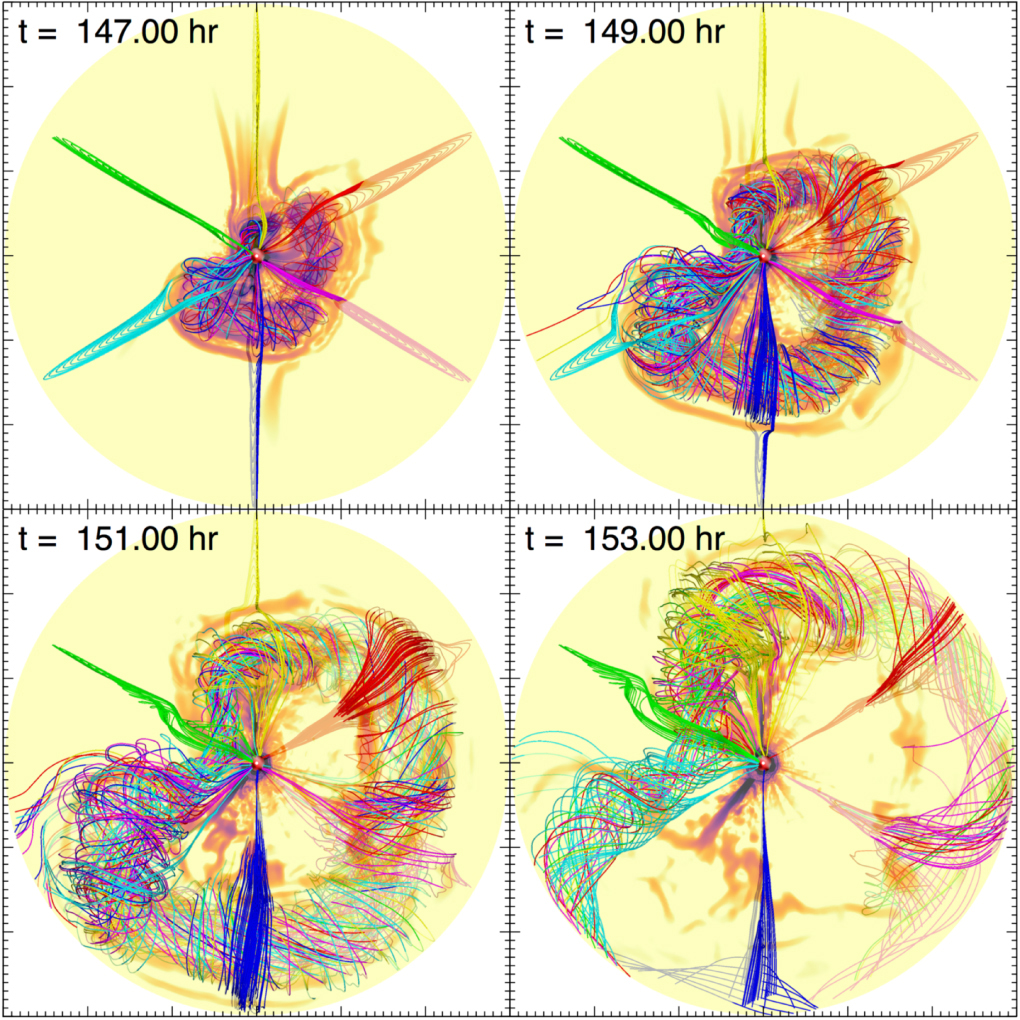Researchers Model Superflare from Sun-Like Star at NCCS

In this artist's illustration, the young Sun-like star Kappa Ceti is blotched with large starspots, a sign of its high level of magnetic activity and the potential for super-powerful stellar storms. Note: The physical sizes of the star and the hypothetical Earth-like planet with protective magnetic field—and the distance between them—are not to scale. Illustration by M. Weiss, Harvard-Smithsonian Center for Astrophysics.
NASA and university researchers modeled a gigantic superflare and coronal mass ejection from Kappa Ceti—a Sun-like star 29 light-years away from Earth—employing NASA Center for Climate Simulation (NCCS) high-performance computing resources.
The simulated explosion released ~700,000 times the energy used by all humans on Earth over an entire year, an event as powerful as our Sun’s famous 1859 Carrington superstorm. A solar storm of this magnitude today would widely damage communications and electrical power infrastructure, with $40 billion in daily economic losses in the U.S. alone. Astoundingly, observations show superflares 10 times more powerful erupting from Kappa Ceti.
The computations used the 3D Adaptively Refined Magnetohydrodynamics Solver (ARMS) code developed by NASA Goddard Space Flight Center’s Rick DeVore, Spiro Antiochos, and collaborators. The ARMS simulation described in the research team’s Astrophysical Journal paper ran on 256 cores of the NCCS Discover supercomputer for ~200 hours. The simulation produced 300 gigabytes of data later moved to NCCS local storage for analysis and visualization, yielding another 300 gigabytes of data.
These results show that global-scale shear can energize the closed magnetic field lines of the stellar corona (atmosphere) sufficiently to power an eruptive superflare from Kappa Ceti releasing as much energy as the massive Carrington event.

These computer-modeled images depict the changing magnetic field lines during the eruption of a superflare and coronal mass ejection from the star Kappa Ceti. The magnetically closed stellar atmosphere is sufficiently energized that the sheared and twisted fields become unstable and erupt, creating a massive 3D magnetic flux rope ejection encircling the entire star. Viewpoint shown is above the north pole of the star (orange sphere at image center). View animation.
Within the observed constraints on the surface magnetic flux, this global-scale eruption represents the most extreme stellar space weather event possible and sets a baseline for comparison with observations of superflares on Kappa Ceti and similar stars.
“From a theorist and modeler’s perspective,” explained lead author Ben Lynch, Associate Research Physicist at the Space Sciences Laboratory, University of California, Berkeley, “the availability of high-performance computing infrastructure like NCCS Discover is absolutely necessary for advancing our first-principles understanding of complex, multi-scale physical systems such as solar and stellar atmospheres.
“These resources dramatically increase our capacity for space weather forecasting through the ability to model the dynamic, time-dependent evolution of our own Sun-to-Earth system and to facilitate the application of these tools to more exotic astrophysical environments,” Lynch said.

Shown are magnetic field lines and (color-shaded) current density magnitude in the 3D magnetic flux rope ejection encircling Kappa Ceti. Viewpoints are from three different directions in the equatorial plane of the star. View animation.
More Information:
Lynch, B.J., V.S. Airapetian, C.R. DeVore, M.D. Kazachenko, T. Lüftinger, O. Kochukhov, L. Rosén, and W.P. Abbett, 2019: Modeling a Carrington-scale Stellar Superflare and Coronal Mass Ejection from Kappa Ceti. Astrophysical Journal, 880, 97, doi:10.3847/1538-4357/ab287e.
Kerry Hensley, “Launching a Stellar Superflare,“ AAS Nova, 8/16/19.
Jarrett Cohen, NASA/Goddard Space Flight Center


